Water lock for sewerage: classification of water locks and the rules for its installation
Siphon is one of the essential elements for connecting plumbing equipment to sewer networks. It constantly contains a small amount of water, a water trap, - for sewage, it is simply necessary, because prevents the spread of negative odors. To pick up a siphon, it’s worth understanding this question, is it not so?
We will talk about how a water trap fulfills its duties. The information presented to your attention will help you to easily determine the optimal types of devices for you personally. Reliable information will provide an opportunity to evaluate the practical aspects and make a balanced purchase.
The article accurately describes the design differences of various models, describes the specifics of the installation. Independent masters in the work will help with step-by-step instruction, photographs and a video guide.
The content of the article:
The principle of operation of the hydraulic lock
No matter where in the sewer network the hydraulic shutter is located, its purpose remains the same:
- block water hammer to reduce the load on sewer devices and pipes;
- prevent the penetration of unpleasant specific odors into residential premises.
If the water trap (or siphon) is selected correctly, a favorable atmosphere reigns in the house, and the sewer network goes without repair for a long time.
Designs of different types of hydraulic locks differ, but all of them, one way or another, are pipes with bends of a certain shape, sometimes equipped with additional dead-end or dynamic devices.
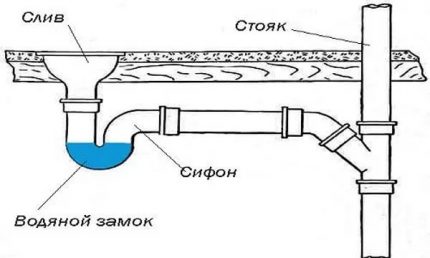
The water barrier is constantly in the siphon.If you do not use the device for a long time (kitchen sink or toilet), the water will evaporate, and eventually it will appear foul odor in the bathroom or kitchen.
The same thing happens when, after a long absence, you first flush. But with constant use, the volume of water in the hydraulic lock is constantly updated, which prevents stagnation, respectively, and the appearance of an unpleasant "aroma".
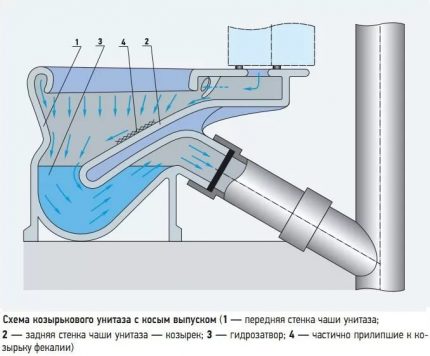
All sewerage devices are interconnected. For example, the right organization fan boner prevents shutter failure - a phenomenon when water does not linger in the hydraulic lock, but immediately goes into the pipe. In this case, the plumbing device is deprived of a protective barrier, and unpleasant odors come out - directly into the apartment.
Types of hydraulic locks for sewage
The classification of devices is made taking into account several factors, but the design features are the main ones. Based on the technical nuances, six main types of hydraulic locks can be distinguished, we will dwell on each of them in more detail.
# 1: Features of the knee modification
Knee water lock can be identified by appearance - it resembles the letter U. The advantage of this type is the strength, which can withstand the maximum pressure in the pipes. The throughput of the device depends on the cross section of the pipe, which should not be less than the output of plumbing equipment.
The main places of the sewer system in which the installation of knee-type water traps is appropriate plum bath and the toilet. Sometimes instead of one, two siphons are connected.
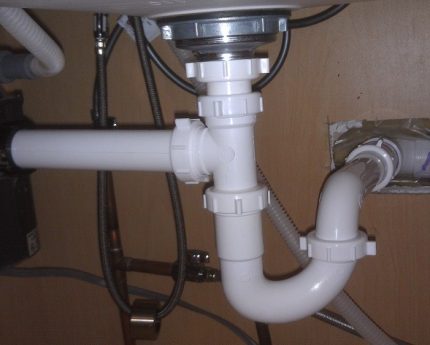
There are various types of knee siphons. Some of them are a single plastic device that can not be adjusted.In case of breakage, it must be dismantled as a whole.
Other devices consist of several parts, so if necessary, you can increase the length of the pipes and change their position in order to adjust the volume of water. The position of the pipes is fixed with plastic clamps and nuts.
The knee has two bends - at the entrance and at the exit. The second inflection point should be slightly lower than the first point (5-6 cm). Sometimes an S-shaped structure is used for a more reliable lock, the principle of its operation is the same.
There are two ways to clean your knee structures:
- by completely dismantling the device;
- special flexible cable.
Some polypropylene modifications are equipped with an inlet for the drain hose of a washing machine or dishwasher.
# 2: Benefits of a Bottle Device
This type of water seal is popular in kitchens for equipping sinks under sinks for dishes. In the process of washing plates and pans, part of the food waste enters the system, which is fraught with the occurrence of blockage.
The design of the bottle model delays food debris, thereby contributing to the preservation of the operational qualities of the sewage system. In addition, the bottle device retains its main purpose - to prevent the appearance of unpleasant odors in housing.
In addition to the pipes that form the basis of any water seal, this type is equipped with an additional element - a “bottle”. This is a kind of container for collecting food waste. The sump is located below the level of the drain pipe, so it is easy to get to it if necessary.
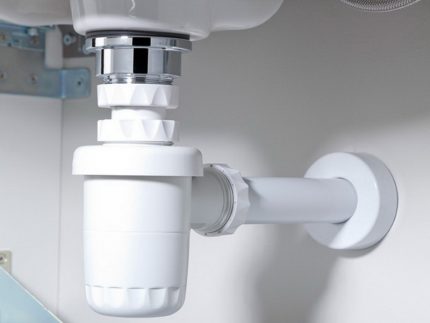
The bottle device is made of polypropylene, but is considered weaker in strength than the knee counterpart. The fact is that unreliable connections cannot withstand the strong pressure of water, therefore this type is used exclusively in the kitchen and is absolutely not suitable for equipping a toilet or bath.
Clogging in the water seal occurs when a dense mass of food debris completely clogs the sump and blocks the path to water. Thanks to the bottle configuration, blocking is very easy.
It is enough to unscrew the laid on nut, which connects the sump, and shake the accumulated debris out of it. Then you need to install the “bottle” in place and tighten the nut more tightly, otherwise water may leak out.
Bottle constructions are also useful from the point of view of preserving objects accidentally caught in the drain. Careless housewives often removed their rings from the sumps, slipping off their fingers while washing dishes with soap and water.
# 3: Two-way shutter device
The design of the two-turn valve is reminiscent of the knee device, but differs in a more complex configuration. A drain pipe is connected to the outlet of the plumbing fixture, and at the junction it is equipped with a filter grill to trap waste, hair and other debris.
Further, it smoothly passes into the knee, which ends with a connection to another pipe. The last element is directed into the drain and is slightly inclined.

Household two-turn structures were previously made of cast iron, now - of polypropylene. Cast iron analogues can only be used in industrial enterprises with increased volumes of effluents and high pressure in the pipes. More presentable are chrome parts, which are close to polypropylene in technical specifications.
If we compare this model with a bottle alternative, then the second option is easier to maintain. However, the two-turn device is more reliable in terms of leakage protection and, thanks to a simple adjustable design, can be installed even in tight places.
# 4: Corrugated Model - Pros and Cons
Among propylene modifications there are also corrugated models - durable, flexible, sometimes just necessary for arranging the sewer system in small-sized rooms. Due to the ductility of the pipe, the corrugation is placed in places where it is difficult to place other types of structures.
It can be rotated at the desired angle and directed in any direction, while firmly fixed plastic has only a few options for position.

However, when choosing a corrugated option, you should know about its only, but significant drawback. The ribbed walls of the pipe seem to be created to collect garbage: leftovers of food, hair, bars of soap, sand and other dirt get stuck in them. Given this, when installing the corrugation, the drain must be equipped with a filter in the form of a fine-mesh lattice.
If you do not clean the corrugated water trap for a long time, under the influence of dirt and excess weight, it loses strength and elasticity. Over time, the folds wear out, begin to crack and let water through.
Having installed a flexible siphon, be sure to monitor its condition and clean it in a timely manner. The contamination of the pipe can be guessed from the sags that are formed in places where fat and debris accumulate.
# 5: Overflow principle
Another type of siphon - with overflow - can also be distinguished into a separate category, since it is necessarily equipped with an additional pipe. The main purpose of the overflow equipment is to protect the apartment from flooding if for some reason the water stops going into the drain when the tap is open.

Be sure to equip the bath overflow system. This method prevents flooding, but, unfortunately, does not contribute to savings. If you want to get a bath and forget to turn off the faucet in time, the water, having reached the overflow level, will safely leave the tank and go into the sewer - along with your money for paying for utilities.
They are presented on the market as economical options made of plastic, yet more durable, but less elastic metal models. Cons of brass-bronze equipment - in the complexity of installation and high cost.
When choosing a device, do not forget to inquire about its bandwidth. If the overflow will not cope with the volume of excess fluid, it is useless and even dangerous.
# 6: Dry Shutter Design
The design of the so-called “dry” shutter is fundamentally different from hydraulic counterparts. It works according to the principle of operation of the “nipple” and is a pipe with a thread inside which a check valve is installed. As a result, water entering the device cannot flow back, just like the smell does not have a chance to leave the pipe.
The installation of such devices is justified on the lower floors of multi-storey buildings, as well as in places where water is used less often (in bathhouses).
Dry gates are not fundamentally installed in kitchen sinks, the use of which provokes the creation of blockages as much as possible. But such water trap devices work efficiently and last a long time in do-it-yourself shower stalls.
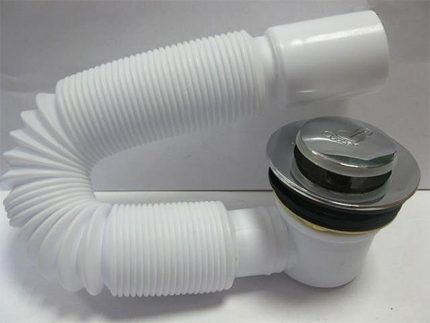
There are several types of dry devices:
- membrane overlapping after draining the water with an elastic membrane;
- pendulum, gravitating to instantaneous closure, if no liquid enters;
- float, closing the hole when the water leaves the drain (acting on the type of fittings of the drain tank).
The latter are often made independently, equipping sewer wiring in the baths.

If suddenly there is a drying up of sewer communications due to rare use, due to the dry shutter an unpleasant smell will not bother you.
Gasket Selection Guidelines
If you are installing or changing plumbing equipment (bath, sink or toilet), you will definitely need a siphon.
To select a device that is fully compliant with plumbing, a number of factors must be taken into account, including:
- dimensions of the device assembly;
- type of siphon;
- material of which pipes and fasteners are made;
- number of drains or additional connections;
- protection against blockages;
- diameter of the inlet and outlet;
- the presence or absence of overflow.
Suppose the most suitable option for washing in the kitchen is a bottle model that traps food particles. A knee device can also be used, but then all the waste will go into the sewer, and over time there is a risk of clogging.
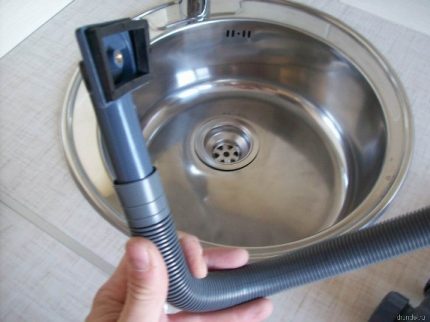
If the project includes a sink or washbasin with two sinks, a device with two drain points is useful. The principle of its operation is the same, the only difference is in the design.
Before buying, be sure to measure the amount of space where the installation will be made. It sometimes happens that the siphon simply does not fit in the designated place (especially the tight gap between the bathroom and the floor). If you choose a water seal correctly, there will be much less problems with its installation and repair.
In the event that the water trap from the siphon is pulled into the sewer, the system is modernized by installation vacuum valve:
Installation instructions for automatic siphon
Installing a bottled hydraulic shutter under the sink of a kitchen sink is quite simple, under the bathtub it is a little more difficult due to the inconvenient location of the drainage system. We present the installation instructions for the automatic siphon for the bathroom - an advanced device that you can install yourself.

First we equip the overflow hole. To do this, take the elastic gasket that comes with the kit and insert it into the hole on the wall of the bathtub. For a tighter fit, you can use silicone sealant.
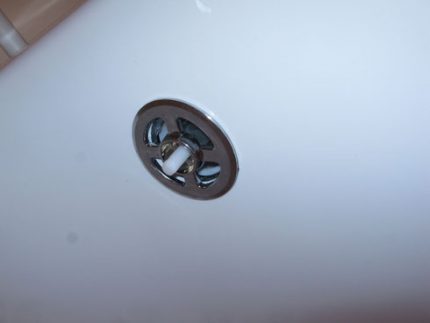
Then we take the next detail - the lamb - and try to carefully fix it on the rod with a bolt. To do this, you need a small flat screwdriver that can penetrate through a small hole in the side of the wing.
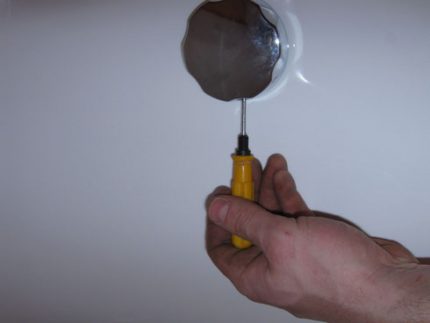
Next, go to the bottom and take the fittings to design the drain hole.
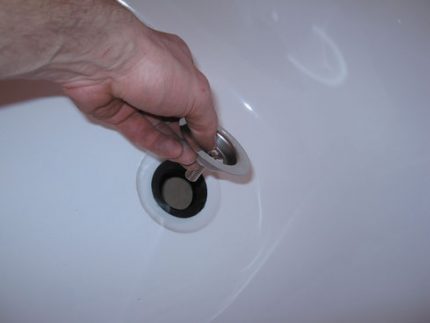
Among the fasteners we find a long fixing screw, which is responsible for fixing the siphon, and screw it on the upper side, holding the bottom structure.
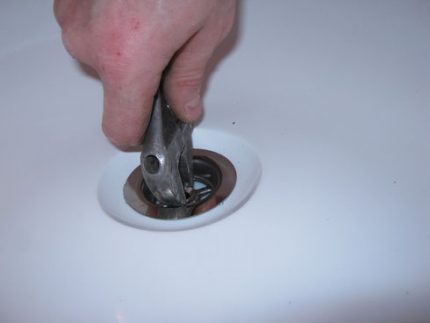
It remains to screw the water seal element. First, we put a rubber gasket on the plastic drain outlet, then we insert the knee bolt. Tighten the outer plastic nut - the design is ready.
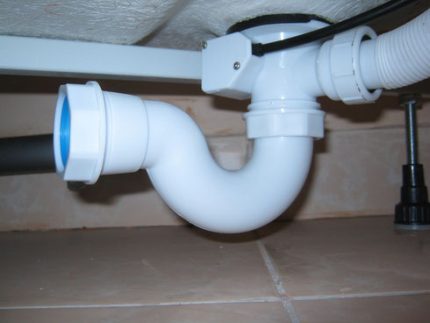
Lastly, we attach a polypropylene pipe (straight or corrugated) to the sewer leading to the sewer pipe.
We test the system - we pour a full bath of water and check the operation of the overflow and drain hole. We look for leaks. If we find a leak, tighten the nuts more tightly, and coat the joints with sealant, but on condition that they do not have to be opened in the future to clean the clog.
Details with workflow and rules installation of a siphon under the bath will familiarize you with the article, the contents of which we recommend that you read.
Conclusions and useful video on the topic
To ensure that the installation process runs smoothly and without errors that plague amateur plumbers, we suggest watching useful videos.
Video # 1. The best option for equipping a kitchen sink:
Video # 2. Installation of a siphon when installing a bath:
Installing a sewer siphon is a process that even a novice who is ignorant of plumbing can overcome the strengths of. If you correctly determine the type of hydraulic lock and carefully read the instructions, you only need to screw a few details. Work for half an hour - and a comfortable atmosphere in the house and the absence of an unpleasant smell - for years.
Please write comments in the block below. We and visitors to the site are interested in your stories, tips, brief photo reports about installing siphons with your own hands. Ask questions about controversial points that you might find in the article.

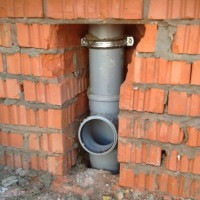 Sewerage ventilation in a private house: schemes and design rules
Sewerage ventilation in a private house: schemes and design rules  Do-it-yourself sewerage in an apartment: rules for internal wiring and installation
Do-it-yourself sewerage in an apartment: rules for internal wiring and installation  Corrugated pipes for external sewage: types, rules and standards of application
Corrugated pipes for external sewage: types, rules and standards of application  Cast iron pipes for outdoor sewage: types, features of application and installation
Cast iron pipes for outdoor sewage: types, features of application and installation  The smell from the sewer in the apartment: types of technical malfunctions and methods for their elimination
The smell from the sewer in the apartment: types of technical malfunctions and methods for their elimination  Why does the smell of sewage appear in the bathroom and how it can be eliminated
Why does the smell of sewage appear in the bathroom and how it can be eliminated  How much does it cost to connect gas to a private house: the price of organizing gas supply
How much does it cost to connect gas to a private house: the price of organizing gas supply  The best washing machines with dryer: model rating and customer tips
The best washing machines with dryer: model rating and customer tips  What is the color temperature of light and the nuances of choosing the temperature of the lamps to suit your needs
What is the color temperature of light and the nuances of choosing the temperature of the lamps to suit your needs  Replacement of a geyser in an apartment: replacement paperwork + basic norms and requirements
Replacement of a geyser in an apartment: replacement paperwork + basic norms and requirements
At one point, it began to smell terribly from the sink in the kitchen. I noticed that this happens only with a certain wind direction on the street. I decided to consult with a friend - a plumber, it was he who told me that it could be a water seal. He said that it was time to exchange your siphon for something newer. The choice of those is enough. We changed everything in a couple of minutes and well ventilated the room, now everything is fine.
I have a similar problem - the shutter regularly breaks down and there is a terrible smell of sewage in the bathroom. Moreover, several times there was a discharge of sewage into the bathtub. I’m coming home from work - and then there are stinks and dried-up scraps.
He called a locksmith from the management company, but he doesn’t care. Almost kicks made him check the ventilation of the riser, but no use. Says: "everything is fine there." Unfortunately, I do not know any good plumbers I can consult with. Will a simple replacement of the water seal help in my situation or do I need to do something more serious, for example, a vacuum valve?
In your case, mistakes were clearly made during the installation of the hydraulic lock, since it should work clearly, preventing sewer emissions into the bathroom. If you are sure of the correct installation, then we are looking for the source of the problem in the ventilation of the sewer riser, demand from the specialist of the Criminal Code, who checks, written confirmation that everything is normal with ventilation. It is possible that in this case he will no longer be 100% sure! Verified personally.
Farther.The blockage may be higher in the riser, which is logical, since the hydraulic lock breaks down. It is also solved by calling specialists who should conduct an audit and eliminate blockage.
I can also advise a life hack: mount another water seal using two angles 45 ° and one 90 °, 45-90-45. Such a solution should help prevent the breakdown of the valve.
I want to say about the corrugated model. I made repairs with a friend a year ago, they put just such a device. So, recently he told me that it was clogged, and when cleaning, it leaked. If you decide to install a corrugation, then you should choose a better material, well, and be prepared for the fact that you will have to periodically clean the gates. I recommend using liquids for cleaning and for prevention.